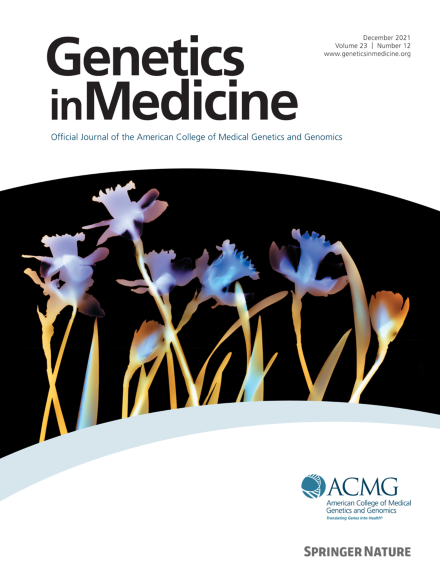LZTR1功能缺失变异的杂合子与孤立的多发性咖啡色黄斑有关。
IF 6.6
1区 医学
Q1 GENETICS & HEREDITY
引用次数: 0
摘要
目的:致病性 LZTR1 变异可导致分裂瘤病和显性/隐性努南综合征(NS)。我们旨在确定杂合性功能缺失(LoF)LZTR1 等位基因与孤立性多发性咖啡色斑疹(CaLMs)之间的关联。方法:849 名患有多发性 CaLMs、缺乏致病性/可能致病性 NF1 和 SPRED1 变体的非亲属参与者接受了 RASopathy 基因面板测序。收集了125名LZTR1杂合子变异者的数据,以确定其临床特征和相关的分子谱。对具有代表性的错义变异和小框架内缺失进行了体外功能评估:结果:分析显示,6.0%(51/849)的参与者存在杂合 LZTR1 变异,超过了一般人群的患病率。与LZTR1相关的CaLM数量不等,边界清晰或不规则,通常是孤立的,但偶尔与RAS病中复发的特征相关。在两个家族中,CaLMs 和精神分裂症同时出现。分子谱主要包括截短变异,表明存在 LoF。这些变异与发生在分裂瘤病和隐性 NS 中的变异基本重叠。功能表征显示蛋白质降解加速或定位错误,以及不能下调 MAPK 信号转导:我们的研究结果扩大了与 LZTR1 变异相关的表型变异性,LZTR1 变异除了易感于分裂瘤病并导致显性和隐性 NS 外,还出现在孤立的多 CaLMs 患者中。本文章由计算机程序翻译,如有差异,请以英文原文为准。
Heterozygosity for loss-of-function variants in LZTR1 is associated with isolated multiple café-au-lait macules
Purpose
Pathogenic LZTR1 variants cause schwannomatosis and dominant/recessive Noonan syndrome (NS). We aim to establish an association between heterozygous loss-of-function LZTR1 alleles and isolated multiple café-au-lait macules (CaLMs).
Methods
A total of 849 unrelated participants with multiple CaLMs, lacking pathogenic/likely pathogenic NF1 and SPRED1 variants, underwent RASopathy gene panel sequencing. Data on 125 individuals with heterozygous LZTR1 variants were collected for characterizing their clinical features and the associated molecular spectrum. In vitro functional assessment was performed on a representative panel of missense variants and small in-frame deletions.
Results
Analysis revealed heterozygous LZTR1 variants in 6.0% (51/849) of participants, exceeding the general population prevalence. LZTR1-related CaLMs varied in number, displayed sharp or irregular borders, and were generally isolated but occasionally associated with features recurring in RASopathies. In 2 families, CaLMs and schwannomas co-occurred. The molecular spectrum mainly consisted of truncating variants, indicating loss-of-function. These variants substantially overlapped with those occurring in schwannomatosis and recessive NS. Functional characterization showed accelerated protein degradation or mislocalization, and failure to downregulate mitogen-activated protein kinase signaling.
Conclusion
Our findings expand the phenotypic variability associated with LZTR1 variants, which, in addition to conferring susceptibility to schwannomatosis and causing dominant and recessive NS, occur in individuals with isolated multiple CaLMs.
求助全文
通过发布文献求助,成功后即可免费获取论文全文。
去求助
来源期刊

Genetics in Medicine
医学-遗传学
CiteScore
15.20
自引率
6.80%
发文量
857
审稿时长
1.3 weeks
期刊介绍:
Genetics in Medicine (GIM) is the official journal of the American College of Medical Genetics and Genomics. The journal''s mission is to enhance the knowledge, understanding, and practice of medical genetics and genomics through publications in clinical and laboratory genetics and genomics, including ethical, legal, and social issues as well as public health.
GIM encourages research that combats racism, includes diverse populations and is written by authors from diverse and underrepresented backgrounds.
 求助内容:
求助内容: 应助结果提醒方式:
应助结果提醒方式:


